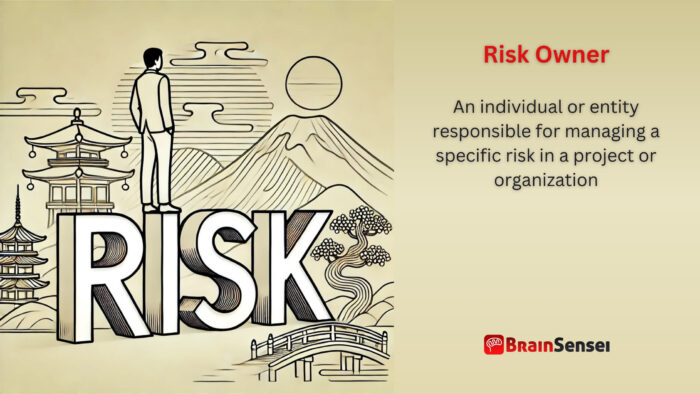
Risk Owner
What is a Risk Owner?
A risk owner is an individual or entity responsible for managing a specific risk in a project or organization. This role involves identifying, assessing, mitigating, and monitoring risks to control them effectively. The risk owner ensures that appropriate actions are taken to minimize potential negative impacts on project objectives.
Key Takeaways
- The risk owner manages and is accountable for a specific risk throughout the project lifecycle.
- They collaborate with stakeholders to assess risk severity and implement mitigation strategies.
- Risk owners must continuously monitor and report on risk status.
- Assigning clear risk ownership enhances proactive risk management and decision-making.
- This role is crucial in highly uncertain industries, such as construction, finance, and IT.
Understanding the Role of a Risk Owner
How It Works
The project or business operation assigns a risk owner to each identified risk. Their responsibilities include:
- Risk Identification: Understanding the nature and potential impact of the risk.
- Risk Assessment: Evaluating the likelihood and severity of the risk event.
- Risk Mitigation: Developing and implementing response strategies to minimize risk impact.
- Monitoring and Control: Continuously tracking risk factors and adjusting plans as necessary.
- Reporting: Communicating risk status to stakeholders and decision-makers.
Key Considerations
- A risk owner should have the authority and expertise to manage the assigned risk.
- Organizations should align risk management strategies with their objectives.
- Clear documentation and communication are essential for effective risk ownership.
- Unaddressed risks can lead to project delays, financial losses, or compliance issues.
- Organizations should periodically review risk ownership to ensure alignment with changing conditions.
Related Terms
- Risk Register: A documented log of identified risks, their owners, and mitigation plans.
- Risk Mitigation Plan: A strategic plan outlining actions to reduce or eliminate risk impact.
- Risk Appetite: The level of risk an organization is willing to accept to achieve objectives.
- Risk Assessment Matrix: A tool to evaluate and prioritize risks based on probability and impact.
- Project Governance: The framework that defines project roles, responsibilities, and decision-making processes.
Examples of Risk Ownership in Industries
Risk Ownership in the Construction Industry
Construction projects face many uncertainties, including labour, materials, weather, and compliance, making risk management crucial. For example, a large-scale commercial construction project in New York risks supply chain disruptions. The project manager identifies this as a significant risk that could delay the project and increase costs. Consequently, the project assigns the procurement manager as the risk owner for supply chain risks.
The procurement manager mitigates risk by diversifying suppliers, negotiating contingency contracts, and maintaining an emergency stockpile of critical materials. They also work closely with logistics partners to ensure alternative transportation methods are in place in case of delays. Regular risk reviews allow the team to adapt to new challenges, such as geopolitical trade restrictions or shortages of raw materials.
By having a clear risk owner, the project minimizes disruptions and ensures steady progress, ultimately reducing financial losses and protecting the project timeline.
Risk Ownership in the Healthcare Sector
In the healthcare sector, cybersecurity risks are growing, especially with the widespread adoption of digital patient management systems. A large hospital in London decides to implement an electronic health record (EHR) system to improve efficiency and patient care. However, this change introduces a significant cybersecurity risk related to data breaches and compliance violations under the General Data Protection Regulation (GDPR).
To ensure effective risk management, the hospital designates the Chief Information Officer (CIO) as the risk owner for cybersecurity threats. The CIO, working with the IT team and cybersecurity specialists, develops a comprehensive risk mitigation strategy. This strategy includes multi-factor authentication, regular security audits, staff training programs, and data encryption protocols.
Additionally, the CIO establishes an incident response plan and ensures swift and transparent handling of potential data breaches. With continuous monitoring and proactive risk management, the hospital protects sensitive patient data, maintains regulatory compliance, and fosters trust within the community.
Risk Ownership in the Financial Services
Fraud risks are high in the financial services industry, especially with digital banking and payment platforms. A multinational bank launching a new mobile payment service has made the Chief Risk Officer (CRO) the risk owner for fraud prevention.
The CRO implements advanced fraud detection systems powered by artificial intelligence. These systems analyze transaction patterns to identify suspicious activities in real-time. They also introduce enhanced customer authentication measures, such as biometric verification and secure transaction monitoring.
To ensure the success of the fraud risk mitigation plan, the CRO works with legal, compliance, and IT teams to establish a regulatory framework that aligns with international anti-money laundering (AML) laws. By taking a comprehensive approach to risk ownership, the bank enhances security, reduces fraudulent transactions, and maintains customer trust.
Organizations can proactively address challenges, improve resilience, and safeguard operations against potential threats by having dedicated risk owners across different industries.
Use Cases of Risk Ownership
United States (IT & Software Development)
A California-based tech company is developing an AI-driven financial analysis tool. One of the main risks is algorithmic bias, which could lead to inaccurate financial predictions and potential regulatory scrutiny. To mitigate this, the company assigns the lead engineer as the risk owner. The lead engineer collaborates with data scientists to conduct extensive testing, ensuring diverse and unbiased training data. They also implement an ethics review process to monitor fairness and transparency in AI-generated results.
Additionally, the lead engineer provides regular updates to the compliance team to align risk mitigation strategies with emerging AI regulations. By taking ownership of the risk, the company avoids reputational damage, maintains regulatory compliance, and builds customer trust.
Germany (Manufacturing)
A German automobile manufacturer plans to expand production into Eastern Europe but faces regulatory compliance risks due to varying labour and environmental laws. The company assigns the operations director as the risk owner for regulatory compliance. This individual ensures the expansion adheres to local regulations by consulting with legal experts and government officials.
The operations director also implements a compliance framework that includes regular audits, employee training programs, and collaboration with environmental agencies to meet sustainability requirements. By actively managing the risk, the company prevents costly legal disputes, streamlines expansion efforts, and maintains its reputation as an ethical manufacturer.
Singapore (Infrastructure)
Singapore launched a government-funded smart city initiative, and climate change is a key risk to long-term sustainability. An environmental risk specialist is appointed as the risk owner responsible for integrating climate resilience into infrastructure development.
The risk owner collaborates with urban planners, engineers, and sustainability experts to design flood-resistant roads, energy-efficient buildings, and green public spaces. They also work with meteorologists to model future climate scenarios and adjust urban planning strategies accordingly.
By proactively addressing climate-related risks, the project ensures long-term resilience, aligns with sustainability goals, and secures investor confidence.
Through these use cases, effective risk ownership enhances project success, minimizes disruptions, and ensures regulatory compliance.
Best Practices for Risk Owners
Effective risk ownership is vital for mitigating potential issues and ensuring smooth project execution. Below are some best practices risk owners should follow to control risks and contribute to successful project management.
Assigning Risk Ownership to the Right Individuals
Organizations should assign risk ownership to individuals with relevant expertise, which is a fundamental best practice. A risk owner should deeply understand the specific risk, have industry knowledge, and have the authority to implement mitigation strategies. Assigning risk ownership based on expertise prevents accountability gaps and ensures effective risk mitigation.
For example, a Chief Information Security Officer (CISO) working on a cybersecurity project is better suited to managing data breach risks than a general IT administrator. Properly assigning risk owners enables organizations to swiftly and efficiently take appropriate measures.
Establishing Clear Reporting and Escalation Mechanisms
Risk owners should have well-defined reporting structures to communicate risk status and escalate critical issues when necessary. They should also conduct regular risk review meetings, where they present updates, highlight concerns, and recommend action plans. Clear reporting structures allow for prompt decision-making and early intervention.
Additionally, organizations should establish escalation mechanisms for risks that exceed the risk owner’s control. If a financial risk threatens the entire organization, it should be escalated to executive leadership for strategic decision-making. This escalation process ensures that high-impact risks receive appropriate attention.
Integrating Risk Management into Project Planning
Risk management should not be a reactive process. Instead, the project team should integrate it into project planning. Risk owners must work closely with project managers and stakeholders to identify potential risks during project initiation and incorporate risk mitigation measures into project timelines and budgets.
Organizations embed risk management into planning to avoid surprises and effectively allocate resources to address potential threats. For example, construction project planners anticipate potential weather-related delays and incorporate contingency plans into the scheduling process.
Continuous Monitoring and Updating of Risk Management Strategies
Risks evolve, requiring continuous monitoring and reassessment. Risk owners should regularly evaluate the effectiveness of mitigation strategies and adjust them accordingly. Risk assessment tools, such as risk heat maps and key risk indicators (KRIs), can help track risk trends.
For instance, market volatility can change frequently in a financial institution. A risk owner managing credit risks must continually update risk models and adjust lending policies to align with economic conditions. Without continuous monitoring, outdated risk strategies can lead to ineffective responses and financial losses.
Encouraging Proactive Stakeholder Engagement
Risk ownership is most effective when stakeholders actively participate in risk management efforts. Risk owners should collaborate with cross-functional teams, customers, regulators, and investors to ensure a holistic approach to risk mitigation.
For example, a pharmaceutical company developing a new drug must engage with regulatory bodies to navigate compliance risks. By maintaining transparent communication and incorporating feedback, risk owners enhance their ability to manage risks proactively.
Maintaining Comprehensive Risk Documentation
Risk owners should document all risk management activities, including risk identification, assessment findings, mitigation plans, and incident reports. Comprehensive documentation ensures that lessons are learned from past risk events and helps future projects avoid similar pitfalls.
Organizations that maintain a detailed risk register create a structured risk-tracking approach. This documentation also serves as an audit trail for compliance purposes and assists in risk forecasting for future projects.
Conducting Regular Risk Training and Simulations
Organizations should invest in risk management training programs to equip risk owners with the necessary skills and knowledge. Training sessions, workshops, and simulations help risk owners stay updated on best practices, regulatory requirements, and emerging threats.
For instance, a cybersecurity risk owner may participate in simulated cyber-attack drills to test incident response strategies. These simulations improve preparedness and response times during actual security threats.
Aligning Risk Management with Organizational Objectives
Effective risk ownership requires alignment with overall business goals. Risk owners should ensure that risk mitigation strategies support the company’s strategic vision rather than create unnecessary operational constraints.
For example, an e-commerce company aiming for international expansion must balance risk mitigation with growth opportunities. A risk owner should implement fraud prevention measures while ensuring a seamless customer experience rather than introducing excessive security hurdles that hinder user adoption.
Conclusion: By following these best practices, risk owners enhance their ability to manage risks effectively, protect organizational assets, and contribute to long-term project success. Organizations prioritizing clear risk ownership, proactive engagement, and continuous monitoring create a culture of resilience and preparedness in the face of uncertainties.
Risk Owner: Common Mistakes and Issues
Assigning the Risk Ownership to the Wrong Person
One of the most frequent mistakes in risk management is assigning risk ownership to individuals who lack the expertise, authority, or experience necessary to handle the risk effectively. When a risk is transferred to someone without the proper background, they may not recognize the full scope of the issue or take the necessary actions to mitigate it. For example, assigning an IT security risk to a finance officer who lacks cybersecurity knowledge could lead to inadequate protection measures and increased vulnerability to cyber threats.
To avoid this mistake, organizations should give individuals with domain expertise risk ownership and the ability to make strategic decisions related to the risk.
Lack of Clear Accountability
Another common issue is the failure to establish clear accountability for risk management. Accountability can dilute if multiple people or departments manage the same risk without a designated leader. This issue leads to delays in risk mitigation efforts, miscommunication, and confusion over who should take action in critical situations.
To address this, organizations should define specific roles and responsibilities for risk owners. Organizations should establish clear guidelines on what actions the risk owner must take, who they must report to, and what resources they can leverage.
Failure to Continuously Monitor and Update Risks
Risks are dynamic and can evolve due to changes in internal and external environments. Treating risk management as a one-time process rather than an ongoing effort is a significant mistake. Organizations that fail to assess and update their risks continuously may find themselves unprepared when new threats emerge.
For example, a company that does not monitor market fluctuations may overlook financial risks that could impact its profitability. To prevent this, risk owners should implement regular risk assessments and adjust mitigation strategies as needed.
Underestimating the Severity of a Risk
Some organizations fail to recognize a risk’s impact, leading to insufficient mitigation measures. This issue is often due to poor risk assessment methodologies, a lack of historical data, or an overreliance on optimistic assumptions.
For instance, failing to properly assess the risk of data breaches in the healthcare industry can lead to regulatory penalties and loss of patient trust. Risk owners should use structured risk assessment tools, such as risk matrices and key indicators, to ensure that risks are appropriately evaluated and prioritized.
Ineffective Communication with Stakeholders
Communication is key to successful risk management, yet many organizations fail to provide stakeholders with adequate updates on risk status. If a risk owner does not communicate emerging threats or changes in mitigation strategies, other teams may remain unaware of critical developments that could impact the project.
Risk owners should establish regular reporting mechanisms like dashboards or status meetings to ensure stakeholders are informed and engaged in risk-related decisions.
Ignoring Early Warning Signs
Organizations could have avoided many major risk events if they had recognized and acted upon early warning signs. Ignoring minor issues or dismissing team members’ concerns can lead to significant consequences later.
For example, neglecting early reports of mechanical failures has historically led to significant safety incidents in the aviation industry. Risk owners should foster a proactive culture where employees feel comfortable reporting potential risks before they escalate.
Not Allocating Sufficient Resources for Risk Mitigation
Risk management requires investment in resources such as training, technology, and personnel. One of the organizations’ most prominent mistakes is failing to allocate sufficient resources to mitigate risks effectively.
For example, a company that identifies cybersecurity as a risk but does not invest in proper security software and employee training exposes itself to data breaches and cyberattacks. Risk owners should work with leadership to ensure appropriate budgets and resources adequately address risks.
Overcomplicating Risk Management Processes
While a structured risk management approach is essential, overly complex processes can deter teams from effectively engaging in risk management activities. A risk ownership framework that is too bureaucratic may discourage proactive risk management.
To prevent this, organizations should strive to balance thoroughness and simplicity. Risk management frameworks should be clear, practical, and easy to follow without unnecessary complexity.
Conclusion: By addressing these common mistakes and issues, risk owners can improve their ability to manage risks effectively. Organizations should focus on assigning risks to the right individuals, establishing clear accountability, maintaining proactive monitoring, and ensuring effective communication. With these practices in place, businesses can enhance their resilience and preparedness in an increasingly uncertain environment.
Risk Owner: Frequently Asked Questions (FAQs)
Can a risk have multiple owners?
Yes, particularly for complex risks that span multiple departments. However, the organization should designate a primary risk owner to ensure accountability.
What happens if a risk owner fails to manage a risk effectively?
Project leaders or governance bodies should intervene, reassess the ownership, and implement corrective measures if a risk owner does not take appropriate action.
How is a risk owner different from a risk manager?
A risk owner is responsible for a specific risk, while a risk manager oversees an organization’s broader risk management framework.
How often should risk owners review their risks?
Risk owners should review risks continuously, with formal reassessments scheduled at key project milestones or organizational review periods.
Who assigns risk ownership in a project?
Project managers, risk management committees, or executives typically assign risk ownership based on expertise and authority.
Additional Resources
- Fundamentals of Risk Management: Understanding, Evaluating and Implementing Effective Enterprise Risk Management
- Project Risk Management: 6 Steps to Succeed
Preparing for a PMI certification?
- Exam Prep Courses: PMP®, CAPM®, and PMI-ACP®
- Exam Simulators: PMP®, CAPM®, PMI-ACP®, PMI-PBA®, PMI-RMP®, PMI-SP®, PgMP®, and PfMP®
- Professional Development Units (PDUs): 15, 30, and 60 PDU Bundles



